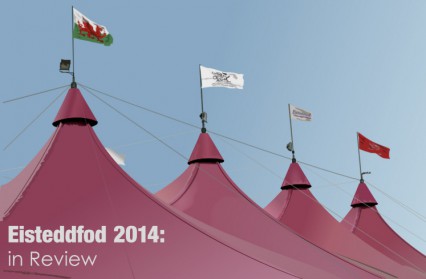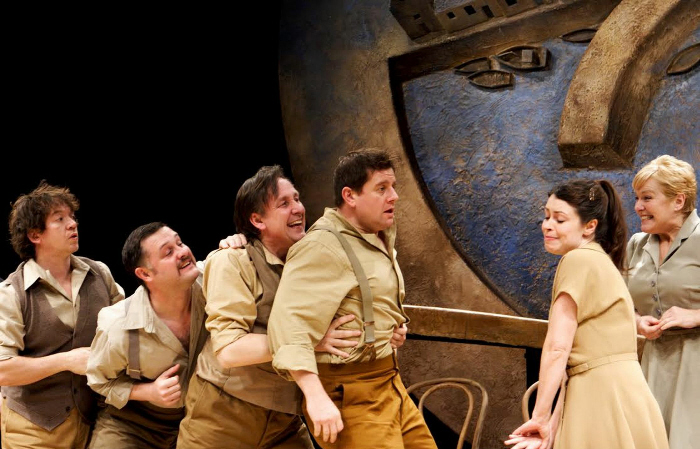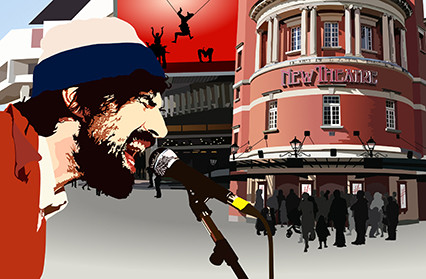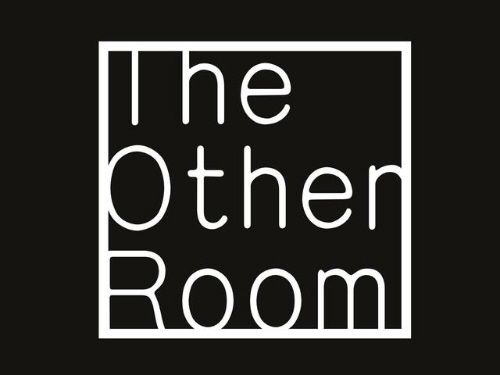It’s that time of year again, and Wales Arts Reviews’ writers have been choosing their cultural highlight of the year. The brief was simple, it had to be something that happened in 2014 and it had to be something that left a mark on that writer’s psyche. In three parts, we see impassioned writing on a diverse range of subjects, and also see the emergence of a striking cultural map of 2014. Part One takes in topics that include festivals, pop controversy and the Wales Book of the Year Award.
Elin Williams
Before I start recounting my cultural highlight of the year, I thought I’d begin by putting it in a personal context and starting with my earliest memory of the Eisteddfod.

I was eight years old. My father and I had to travel up to somewhere called ‘the gogs’. It was a long way in the car, on windy roads, but I didn’t mind because I was sure my school choir would get to be on the television when we undoubtedly won first place with our rendition of that song that I knew in my sleep back in 1998 but come 2014 has completely deserted my brain. The experience didn’t exactly get off to a good start. My dad got pulled for speeding which was highly traumatic for him, being lectured by a colleague who remembered him from police training. We eventually got to a place they called ‘Rhyl’ which could quite easily have been Royston Vasey. We stayed in a run down B and B owned by a frantic looking woman who wore too much lip liner and was married to an elusive Italian man who never made an appearance. She kept presenting me with a microwavable pizza at meal times and told me the proper Italian way to pronounce Pizza was ‘Pitsa’. I was eight, and I still knew she was talking cobblers. The day of the competition, we got lost on the maes, missed the competition and a steward manning the doors at the Pabell gave me a pound for an ice cream because he felt sorry for me. My school didn’t get through to the stage and I won a Budweiser frog on one of those crane machines in Rhyl arcade.
So there you have it, my first experience of an Eisteddfod, yet I still went back for more.
This year’s Eisteddfod Genedlaethol was in Llanelli, literally five minutes from my flat which I happened to move out of a week before the Eisteddfod actually opened. The sight of the Pabell Pinc loomed over Llanelli’s sea front and boasted a fantastic cross section of Welsh cultural life. This year, I insisted my boyfriend came with me. My request was met with trepidation. That old classic, ‘But I don’t speak Welsh’ rolled out for the umpteenth time. I sighed, and assured him that he would be surprised by how much he was able to access.
I mention this because I think it is a common misconception about the Eisteddfod; if you don’t speak Welsh, you won’t understand any of it. Well let me tell you, he had a great time in that Welsh Ale tent. I’m joking of course. He enjoyed two welsh language plays, one by Theatr Iolo, the other a translation of Under Milk Wood which was broadcast live onto BBC Radio Cymru. He perused the arts exhibitions and enjoyed a few choirs in the mighty pabell. In fact, we had a really great time.
The Eisteddfod App was an absolute godsend this year. It let’s you map out your day very easily. There was so much too see, I ended up running from place to place in order to cram as much in as possible. There were ample food and drink tents, Welsh stalls and plenty of places to sit and relax with friends. Combined with the glorious weather, it really was worth the money.
The only shame is that the Eisteddfod never seems to be covered very much by the English language Welsh press. More of a noise needs to be made about this fantastically rich cultural event, and people should embrace the opportunity to spend a day enjoying the creative outputs of our great Nation.
Steven Hitchins
This year the annual North Wales International Poetry Festival brought some of the most exciting contemporary voices from Serbia, Poland, China, Cuba, the Czech Republic and Slovakia to Wales to read alongside Welsh poets. One of the most memorable moments of 2014 for me was being invited to read alongside Czech poet Olga Pek and Slovakian poet Zuzana Husarova. Both gave fascinating individual readings where they combined poetry with digital sound manipulation: Husarova using touch-sensitive laptop sorcery to pluck metallic twangs from her voice and Pek using handheld devices to create an accompaniment of atonal bleeps and drones. But the highlight for me was the finale, where the two poets read together for the collaborative performance ‘Amoeba’.
‘When an amoeba divides in two does it go out of existence?’ In a dark room, lit only by the white light of the projector screen and the glow of their digital reading devices, Husarova and Pek stand at either side of the room in white robes. They take turns to read short passages that mutate the scientific and the poetic to trace a morphology the amorphous. Behind them, fractal microscope glitches wriggle and drift across the screen, while the soundtrack emits a steady swell and ebb of alien breathing: a submarine wash of dissonant hum and muted roar.
The poets stretch a length of white fabric between them across the width of the room and rustle it into flux-waves, tiny catastrophes wrinkling and rippling. They hide beneath the fabric, one poet at each end, crouched silhouettes lit by the LED-blink of their iPads, pawing and undulating towards each other as they speak. When they meet they read in unison, the room now magma red, the soundtrack twitching into a clicky almost-beat, as the cloaked poets sway together, a protoplasmic jelly, chanting bio-rap. The amoeba divides, they collapse to the floor, beneath the fabric. A recorded voiceover speaks: ‘This is how we would define the feminine textual body…’
My brain bifurcating in its attempt to keep up, only now do I start to perceive what the poem has been evoking for me: some sort of fractal metamorphic model of textual consciousness. ‘By thinking we have become, within us it has come, to an eternal return,’ a voice says. It is exciting when a poetry performance can shape the space of your reading of the text to you in a way that inspires awe and slight terror. For me, the performance was even more powerful for the fact that I couldn’t put my finger on what exactly it was that it had suggested to me. Something to do with texts and reading and consciousness… the endlessly recurring and diverging forms the text takes in our thinking of it. It felt like I had been shown something amorphous, taken through an experience of this formless amoebic textual body forming and dissolving. ‘Pray to us if you will, precious reader, but it is up to you to answer yourself, as we enounce you… terminal.’
Phil Morris
The highlight of my theatrical year was the news that The Other Room is to open in February 2015. This new theatrical space might be small in size, with a seating capacity of just 44, but in terms of artistic ambition the venture is huge. A key factor in its success will inevitably be its Artistic Director, Kate Wasserberg, who has an impressive track record in working with leading playwrights including Nick Payne, Tim Price and Mike Bartlett (among others) during her time as an Associate Director at Clwyd Theatr Cymru and the Finborough Theatre in London. The company has given itself the remit of producing both new works and modern classics (post 1950) in support of Welsh and Wales-based theatre artists.
Whereas the focus of National Theatre Wales tends to be on developing new work in sprawling, immersive, site-specific projects – and while the Sherman Theatr Cymru struggles to overcome its much documented problems with a rather conservative programme of Shakespeare and fairy-tale adaptations – it is essential that there exists in the Welsh capital a permanent home for new plays. If Welsh theatre is to continue to thrive, a plurality of creative voices must to be fostered and heard across a range of different types of theatre buildings. The siting of The Other Room within Porters of Cardiff will prove to be a valuable addition to the vibrant fringe scene currently flourishing in the city. Wasserberg hails from Stoke-on-Trent and her decision to base her new company in South Wales will be regarded as a fortunate one for the capital’s theatregoers.
It is also gratifying to note that in parallel to the daring artistic policy of The Other Room, its Executive Director Bizzy Day has led an innovative and wide-ranging fundraising effort, which has included a tremendously successful crowdfunding campaign that raised thousands of pounds earlier in the autumn. Bizzy’s work will underpin the long-term viability of the venue, which will not only stage in-house productions but also present work from two other resident companies, Gagglebabble and Difficult Stage.
The Other Room team will be releasing daily snippets, pictures and teasers about their opening season, titled Life In Close Up, via their website www.otherroomtheatre.com. Wasserberg will direct the first production of a season that will ‘take worlds that we are used to seeing at a distance, and show them in close-up’.
The two most acclaimed theatre productions of 2014 by Welsh writers – Teh Internet Is Serious Business by Tim Price (Royal Court) and Land of Our Fathers by Chris Urch (Theatre 503) – were both staged in London. I have a hunch that plays from The Other Room will feature prominently in the 2015 cultural highlights pages of Wales Arts Review.
Barbara Michaels
Infused with magic from the moment it opens, Terry Hands’ production for Clwyd Theatr Cymru of Dylan Thomas’s Under Milk Wood brings out every nuance of this, the most famous of Thomas’s works. Not only do we have the richness of language, character and humour for which this ‘play for a voice is justly famous, but Hands gives us glimpses of the darkness behind the façade of respectability – and otherwise.

For this reason, I have no hesitation in naming this production as standing head and shoulders above the rest. In keeping all the beauty of the original in language and characterisation, Hands loses not one iota of the spirit of the writing, while in addition probing beneath the surface in order to project an understanding of what lies beneath the eccentricity of the characters.
A sole backcloth, designed in the round by Martin Bainbridge, depicts the little town of Llareggub nestling at the water’s edge beneath Milk Wood; sensitive lighting enables changes of colour as the action moves seamlessly from night to day. From the very beginning, as the full cast walks on stage, and narrator Owen Teale speaks the opening lines, this small team of actors, without exception, rise superbly to the challenge of portraying Dylan’s clutch of eccentrics living out their lives. I am sure I am not the only who felt the classic rising of the hair-at-the nape of the neck that is indicative of being present at a performance that is unique.
The pivotal role of Captain Cat is played with sympathy by Ifan Huw Dafydd (as one might expect from an actor who has won a BAFTA Cymru award), who also plays the part of Mr Waldo; owing to the small size of the cast (just thirteen – less than half of the number in the original) there is considerable doubling of roles. It seems invidious to single out individual performances, for in some respects this piece could be described as having an ensemble cast. However, mention must be made of Steven Meo’s Nogood Boyo and Willy Nilly – the former so full of the rich and raunchy humour that Thomas does so well – which rank up there with the best.
Playing no less than six of the characters – a formidable task which might well dismay the most experienced of actresses – Sara Harris-Davies changes style adroitly, at one moment waddling across the stage as Mrs Organ Morgan, the next taking on the persona of Rosie Probert, dealing equally well with other characters she portrays.
In the year celebrating the centenary of Thomas’s birth there have been, not surprisingly, multiple stagings of his work, ranging from the excellent through average to those interpretations which contribute little to the understanding of the work. The all-Welsh cast of Clwyd Theatr Cymru’s production of Under Milk Wood present a fitting and atmospheric tribute to the Welsh poet and playwright, and one that is worthy of an award in its own right.
Craig Austin
It’s likely that you’ve already formed a fairly firm opinion of Lana Del Ray, by now. Yet your opinion, much like mine, is likely to have been based on little more than guesswork. For one of the most fascinating elements of the LDR persona is the artist’s unashamed desire to retain the once customary illusion of detached pop ‘otherness’. In this instance, a calculatingly indefinable essence of old-school Hollywood glamour and a distinctly 20th century approach to the notion of celebrity. One anchored firmly within the shuttered bungalows of the Chateau Marmont rather than the 24-hour digital peepshow of the information super-highway.
LDR, like all the best pop stars, divides opinion like cheese-wire; her beguilingly languid presence at this year’s Glastonbury festival acting as the perfect provocation for those who view the ongoing ambiguity of the artist’s intent as a personal affront. Her performance – as ever – was an impeccable de facto casting call for some abstract David Lynch movie; the camera recurrently focusing in upon the tip of her cigarette as it glowed in the afternoon breeze and the colourful collision of her arresting Haight Street summer dress. In keeping with the entire LDR oeuvre, it was a cinematic performance as much as it was a musical one. For your consideration: the Summer’s finest supporting actress; languid Lana, lugubrious Lana, lazy Lana.
For LDR the curse of modern-day urban ennui is presented as a glamorous occupation, if not a noble pursuit, in itself. Not since the embryonic Manic Street Preachers has an artist celebrated boredom to such a remarkable extent. Within the lush and multi-layered complexity of this year’s magnificent Ultraviolence album, and despite its prevailing themes of suppressed cruelty and passionate destructive love, LDR rarely deviates from her role as world-weary narrator and detached observer; a woman complicit in the prevailing contemporary exchange of depth for surface. ‘I like my candy and your heroin,’ she intones on ‘Cruel World’ – a jarring pop lyric in the current formulaic scheme of things – as she retreats into an illusory fug of narcotic ambivalence. She can hear sirens, she can hear violence, but she’s seemingly too wrapped up in her customary role as the jaded damaged prom queen to do anything much about it.
The assured, unhurried beauty of Ultraviolence – and my, is slowness in pop music an underrated quality these days – is loosely underpinned by a persona-flipping, nation-traversing theme in which LDR travels from Brooklyn to Brentwood and back again. A world in which nothing of any consequence exists outside of the steamy fleshpots of New York and Los Angeles, yet one that still manages to stumble home with its clothes reeking of Kentucky bourbon and Virginia tobacco. In this sense, America is presented as the canvas, and personal plaything, of the artist herself. When she sings ‘You got your bible, got your gun / And you like to party and have fun’ – a line ostensibly about an unreliable boyfriend, the constantly recurring ‘Jim’ – she might as easily be addressing the U.S.A itself.
We may never know who the performer really is, or where the worlds of Lana Del Ray and Lizzy Grant truly intersect (if at all). In the best tradition of the aforementioned David Lynch, the flimsy clues that ‘Ultraviolence’ purportedly offers us are as oblique and impenetrable as the artist herself. A gratifying absence of transparency within a culture of permanent accessibility.
John Freeman (Live Performance)
I was present at Gavin Goodwin’s launch
the first public reading of
I’d read the pamphlet to myself before,
and the earlier drafts which were much longer,
and so I thought I knew what to expect.
But the performance was a revelation.
Like a solemn artist on a wire
high overhead he kept his concentration
and never put a foot wrong, although
one time he stumbled just enough to make us
see how far down it was if he should fall.
But he stepped on, and we were up there with him,
our hearts in our mouths, as out of his mouth
a dozen different voices spoke their pieces,
he doing them with no exaggeration
but just enough difference between them.
We had no trouble following transitions.
The tension built, he was half-way across.
If he should lose it now, if he should lose us.
Instead there was a new insistent rhythm,
and there before us, swaying only gently,
from walking he was dancing, he was flying,
and we were flying with him to the climax,
when he landed us somewhere high up,
safely on the far side of a canyon,
having lived a lot in a little space,
and finding in ourselves implanted after
like an extra heart with a new beating,
a seriousness, a rhythm, a compassion,
understanding, and a kind of flowering.
Note: Gavin Goodwin’s Estate Fragments was published by The Knives Forks And Spoons Press in 2014. Drawing on Goodwin’s own upbringing on the Bettws Estate, Newport, interviews with other residents, and years of academic research, Estate Fragments condenses a great deal into a relatively short collage of voices. On 18 October Goodwin was one of four readers in an evening of poetry at the Owain Glyndwr in St John’s Street, Cardiff. I wrote this poem on the following day.
Jasper Rees
Although they were all published last year, forgive me for starting with the leading runners and riders for the 2014 Wales Book of the Year Award, of which I was a judge in the English-language categories. I’d strongly recommend the three winners: Pink Mist, Owen Sheers’s verse drama about callow Afghan veterans (the overall victor), Francesca Rhydderch’s novel The Rice Paper Diaries set in Newquay and Hong Kong in World War Two, and Meic Stephens’ Rhys Davies: A Life. I also can’t praise highly enough Tyler Keevil’s The Drive, a psychedelic West Coast road trip for one young man and his cat.
As it was published two days into January, Horatio Clare’s Down to the Sea in Ships was not eligible for our deliberations. A boyishly enthusiastic, access-all-hinterlands portrait of life on container ships – on which all our lives pretty much depend – it earns its place in the noble tradition of British maritime literature.
Sheers crops up again as the author of Mametz, NTW’s contribution to the centenary of 1914. Set on a Monmouthshire farm, it did what good war stories should: get you invested in the humanity of the participants, then knock you in the solar plexus. None of us can know what it was like to go over the top, but Mametz gave it a good shot. Rumour has it that the production may return. If so, book.
As for the other centenary, A Poet in New York starring Tom Hollander as Dylan Thomas felt like a faithful likeness. Of all the many DT100 events, a special shout-out for the Dylan Thomas in Fitzrovia festival, the brainchild of Griff Rhys Jones but curated by Jason Morell, who commissioned two very different portraits of the marriage of Dylan and Caitlin. Dance company Thick and Tight performed an intimate suite for two. A Warring Absence, starring Sian Thomas and Daniel Evans, turned up the volume through his letters and her memoir. Both deserve a longer life.
Anyone interested in Englishness should not miss Matthew Engel’s book about all English counties. Engel’s England is a hilarious and stirring tour of 39 varieties of local identity (plus a chapter on London to make up the numbers). And then there’s Britishness. Two National Theatres – of Scotland and of Great Britain – collaborated on a tumultuous trilogy of history plays. I ingested The James Plays in one day and emerged as enthused about the immersive potency of theatre as at any time in 2014. Another insightful drama about royalty was Mike Bartlett’s so-called “future history play”, King Charles III, which transferred from the Almeida in north London to the West End.
On television it was cheering – in the excellent Hinterland/Y Gwyll – to see work by S4C get a platform across the network on BBC Four. Of other police procedurals, my favourite was Channel 4’s 24 Hours in Police Custody, which grippingly harnessed the grammar of drama to show actual coppers tackling crime in real time.
Finally, who could resist American Interior, Gruff Rhys’s multi-platform account of an itinerant Welshman? Not I.
Go to Wales Arts Review’s Highlights of 2014 Part Two
original illustration by Dean Lewis













